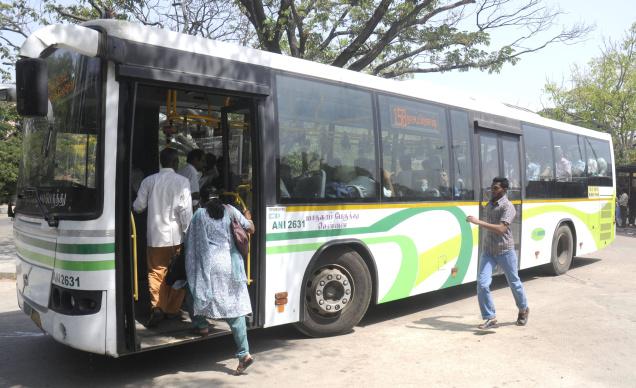The Metropolitan Transport Corporation (MTC) transports about 5 million people everyday. Yes it is 5 lakh people every day. This is roughly like moving all the cities of Singapore every single day. For an organization that is doing the unthinkable, they seem to on a daily basis getting brick bats with rarely an appreciation of any kind. So what does it take to make MTC an even bigger success story and claim the glory that is once had. This article aims to create a broad framework based on best practices from other successful bus corporation across the world.
Number of Buses (More Needed)
According to the Urban bus toolkit of world bank every city needs about 40 – 120 buses per lakh of population. Going by that standard, with a Chennai Corporation limit population of 7.5 million we need about 5500 – 6000 at the lower spectrum of the buses. However, MTC has only 3900 or so buses, and to add to the problem is that everyday about 300 buses don’t operate due to various reasons.
If you look at the historic ridership, MTC ridership has increased year on year however their mode share has come down. This is surely a worrying trend for the city as it is very difficult to wean users away from other modes to public transport.
Route Structure
One of the first things necessary for MTC is to simplify the route structure. MTC currently has about 3900 buses that it operates on a daily basis. These buses operate along 750+ routes. About 92% of these routes operate within 426 sq. km of Greater Chennai Corporation. By spreading its services across so many routes, reliability and dependence on any routes remain limited.
Unified Fare Media (Common Ticketing)
A unified ticketing system both in terms of fare media integration and modal integration will significantly increase access to the bus system. Many cities like Bangalore, Ahmedabad etc… have already started fare media integration. This will allow citizens to use the same card to access both the bus, rail and retail ecosystem. With newer technologies like Open Loop system as mandated by National Common Mobility Card (NCMC) system provide a great future.
Simplified Fare Structure
The fare structure of MTC is among the most complicated in the transit world. MTC currently has almost 14 stages of fares. This makes predicting the cost of of travel much simpler. For example London has a transport system with only 6 stage fare system for its longest routes. Even for the bus operator like MTC it is very convenient to manage fare box revenue.
Staffing
The transit industry has undergone significant changes both in terms of the technology within the ICE engines and also with planning. It is necessary to upgrade the skill sets of the staff to keep operations more customer centric / focused. Also considering the fact that MTC is going to procure a 1000+ electric buses, it is necessary to skill the technical staff to understand the newer drive train.
Information Technology System
MTC currently uses limited intervention of Information Technology to increase its maturity in delivery of services. MTC should use Information Technology in Planning, Communication, Marketing and also internal office work. This would significantly increase the capability of the state transport corporation.
Passenger Information System
MTC transports about 5 million passengers everyday. Currently the information about bus arrival, departure and arrival is currently not available to the bus riders. This reduces dependability and reliability of the services.
By providing a proper passenger information system the commuters of MTC can plan their journey based on the bus arrival and departure time.
Operations Time
MTC currently operates 3 shifts. Morning shift starts at 5 and goes on till about 2 p.m. and the second shift starts are 2 p.m and ends at 10 p.m. There is an all day shift where such drivers do alternate day services.
The current all day occupancy dates of MTC are 83%. However more than 50% of this demand is centered around peak time. So MTC should provide services aligned along with the demand. More uses must be operated during the morning peak from 8 a.m to 11 a.m and evening peak from 5 p.m to 8 p.m.
Communications and Marketing
Transit operators should communicate about their services and must actively have a 2 way communication to understand the need of its users. This would create a service provider who will have sustainable operations.
MTC must conduct more surveys and market research to understand its customers better to offer a more sustainable service.

